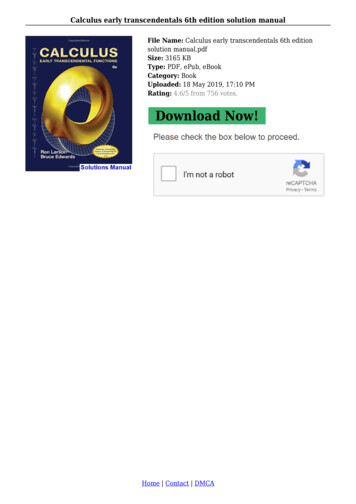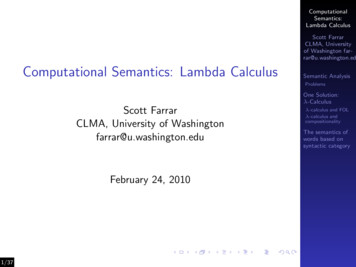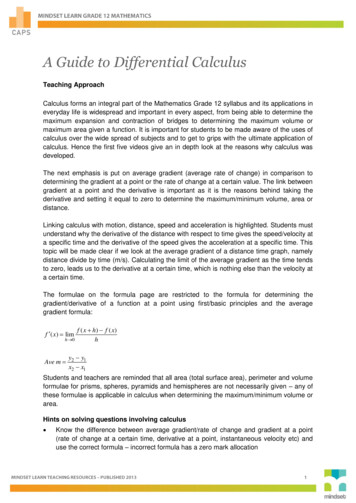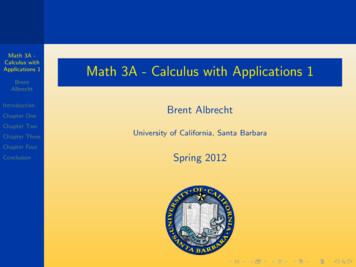
Transcription
Single Variable Calculus, EarlyTranscendentals978-1-63545-100-9To learn more about all our offeringsVisit Knewton.com
SourceAuthor(s) (Text orVideo)Title(s)Link (where applicable)OpenStaxGilbert Strang,Massachusetts Instituteof TechnologyEdwin “Jed” Herman,University ofWisconsin-StevensPointCalculus Volume 1Calculus Volume 2OpenStaxMathispower4u VideosJames SousaMathispower4u VideosAlta Single Variable Calculus was developed to meet the scope and sequence of a typical two-semestercalculus course. To develop the course, Knewton used three main sources of content: Openstax, videoscreated by a Math Professor we have partnered with, and a team of Subject Matter Experts. The SMEscome from diverse backgrounds and are all academics in the field of mathematics.Alta Single Variable Calculus has two instructional sequences for every learning objective, givingstudents multiple opportunities to learn new concepts. Between our OpenStax text content, instructionalvideos, and Knewton SMEs, we were able to solicit ideas from math instructors and students. Alta SingleVariable Calculus covers the typical breadth of calculus topics, and also provides the necessary depth toensure the course is manageable and engaging for instructors and students alike.
Single Variable Calculus, Early Transcendentals Table of ContentsChapter 1: A Review of Functions and Graphs1.1 Review of Functions Functions, Function Notation, and Domain and Range Evaluate a function using function notation and determine the domain and range Represent functions using tables, graphs, or formulas Symmetry of Functions, Absolute Value, and Function Composition Combine functions using mathematical operators or function composition Understand the symmetry of functions and the absolute value function1.2 Basic Classes of Functions Graphing Lines, Parabolas, and Polynomials Find the slope and equation of lines Use tools such as the quadratic formula and end behavior to graph polynomial functions Understand the difference between algebraic and transcendental functions and find thedomain of algebraic functions Piecewise Functions and Transformations of Functions Understand and graph piecewise-defined functions Perform transformations of functions (*1)1.3 Trigonometric Functions Radian Measure and Evaluating Trigonometric Functions Understand radian measure and convert between radians and degrees Evaluate trigonometric functions Trigonometric Identities, Equations, and Graphs Understand trigonometric identities and use them to solve trigonometric equations Graph periodic functions1.4 Inverse Functions Finding an Inverse Graphically and Algebraically Determine when a function is one-to-one Find the inverse of a function Graph an inverse function Restrict the domain of a function to find an inverse function Inverse Trigonometric Functions Evaluate expressions involving inverse trigonometric functions1.5 Exponential and Logarithmic Functions Evaluating and Graphing Exponential Functions Identify and evaluate exponential functions Graph an exponential function Simplify expressions using the law of exponents Understand the base e and use it for application problems Logarithmic Graphs and Properties of Logarithms Convert between logarithmic and exponential form and evaluate logarithmic expressions Graph a logarithmic function Understand the properties of logarithms
Exponential and Logarithmic Equations Solve equations involving exponential functions Solve equations involving logarithmic functions Use the change-of-base formula to evaluate logarithmsChapter 2: Limits and Continuity2.1 A Preview of Calculus A Preview of Differential and Integral Calculus Preview the tangent problem by using secant lines and average rates of change Preview the area problem by using rectangles to approximate area2.2 The Limit of a Function Limits From a Graph or Table Understand the limit of a function and evaluate a limit from a table Evaluate limits graphically Understand the properties of limits Limits Analytically for Continuous and Piecewise Functions Evaluate two-sided limits analytically for continuous functions Evaluate limits analytically for piecewise functions Evaluate limits analytically for absolute value functions2.3 Calculating Limits Using Limit Laws Limits Analytically for Functions with Removable Discontinuities Evaluate two-sided limits analytically for rational functions with removable discontinuitiesby factoring Evaluate two-sided limits analytically for rational functions with removable discontinuitiesthrough expansion Evaluate two-sided limits analytically for complex fractions with removable discontinuities Evaluate two-sided limits analytically for rational functions that contain radicals withremovable discontinuities Limits Analytically for Trigonometric Functions Evaluate trigonometric limits using direct substitution Evaluate trigonometric limits using special limits Evaluate trigonometric limits using identities Infinite Limits Evaluate limits analytically for functions with essential discontinuities Evaluate limits analytically for trigonometric functions with essential discontinuities2.4 Continuity Continuity and the Intermediate Value Theorem Understand the definition of continuity Distinguish between types of discontinuity Understand and apply the intermediate value theorem Continuity of Piecewise Functions Determine whether a piecewise function is continuous Determine the value that makes a piecewise function continuous
2.5 Formal Limits Precise Definition of a Limit Understand the notation in finding the formal definition of a limit Determine a delta for an arbitrary epsilon given a linear function Determine a delta for an arbitrary epsilon given a quadratic functionChapter 3: Differentiation3.1 Defining the Derivative Secant Lines and Average Rates of Change Find the average rate of change given a function Find the average rate of change given a table or graph Find the average rate of change given a function and variable intervals Tangent Lines and Instantaneous Velocities Determine the sign of the slope of a line tangent to a function at a given point Estimate the slope of the line tangent to a point on a curve Estimate the instantaneous rate of change of a function from successively closerapproximations The Definition of the Derivative Find the derivative of a function at a point using limits Use the limit definition to find the derivative of a polynomial function Use the limit definition to find the derivative of a rational function Use the limit definition to find the derivative of a function with a radical Applications Using the Definition of the Derivative Solve application problems using the definition of the derivative3.2 The Derivative as a Function The Graph of the Derivative Function Estimate the value of a derivative at a point on a graph using a tangent line Determine the open intervals where the first derivative is positive or negative from agraph Determine the graph of the derivative function given the graph of a polynomial function Differentiability State the connection between derivatives and continuity Describe three conditions for when a function does not have a derivative Find the constants that make a piecewise function differentiable Determine the graph of the derivative function given the graph of any function3.3 Basic Differentiation Rules The Power Rule and the Sum and Difference Rules Use the constant, constant multiple, and power rule for monomials Apply the sum and difference rules to combine derivatives Use the Power Rule to Explore Tangent Lines Find the equation of the line tangent to a polynomial at a point (*13) Determine where a function has a horizontal tangent Determine the points on a function when tangent lines have a given slope
The Product and Quotient Rules Use the product rule to find the derivative of a function in the form f(x)g(x) Use the quotient rule to find the derivative of a function in the form f(x)/g(x) Use the product rule to find the derivative of a function in the form f(x)g(x)h(x) Combine the product and quotient rules with polynomials Extensions of the Power Rule Extend the power rule to functions with negative exponents Extend the power rule to functions with rational exponents Simplify algebraic expressions in order to use the power rule Use the extension of the power rule to explore tangent lines (*5)3.4 Derivatives of Trigonometric Functions and the Chain Rule Derivatives with Trigonometric Functions Find the derivative of a function with sine or cosine Use the product or quotient rule to find a derivative with sine or cosine Find the derivative of a function involving tangent, cotangent, secant, or cosecant Find the equation of a line tangent to a trigonometric function The Chain Rule Use the chain rule with the power rule Use the chain rule with trigonometric functions Use the chain rule with the product rule Differentiate a composite of three functions3.5 Derivatives as Rates of Change and Higher Order Derivatives Relate Velocity and Acceleration to Position Functions Find the second derivative with the power rule Find the velocity and acceleration function from the position function Determine when a particle is moving left or right Higher Order Derivatives Find a higher-order derivative for sin(x) Determine higher order derivatives requiring the chain rule Other Applications Involving Rates of Change Solve application problems involving rates of change3.6 Derivatives of Inverse Functions and Inverse Trigonometric Functions Derivatives of Inverse Functions Find an inverse derivative function value for a polynomial function Find an inverse derivative function value for a rational function Find an inverse derivative function value for a square root function Derivatives of Inverse Trigonometric Functions Find the derivative of arcsine or arccosine functions Find the derivative of arctan or arccot functions Find the derivative of arcsec or arccsc functions3.7 Implicit Differentiation Use Implicit Differentiation Use implicit differentiation Use implicit differentiation and the product rule
Use implicit differentiation to find a second derivative Use implicit differentiation to find the equation of a tangent line (*14)3.8 Derivatives of Exponential and Logarithmic Functions Derivatives of Exponential Functions with Base e Find the derivative of an exponential function with base e Use product and quotient rules to find the derivative of exponential functions with base e Derivatives of Exponential Functions with Any Base Find the derivative of an exponential function with any base Use product and quotient rules to find the derivative of exponential functions with anybase Derivatives of Natural Log Functions Find the derivative of a natural logarithmic function Use properties of logarithms to find the derivative of a natural logarithmic function Derivatives of Logarithmic Functions of Any Base Find the derivative of a logarithmic function that is not base e Use properties of logarithms to find the derivative of a logarithmic function that is notbase e Logarithmic Differentiation Use logarithmic differentiation with only the power property of logarithms Use logarithmic differentiation with all properties of logarithmsChapter 4: Applications of Differentiation4.1 Related Rates Related Rates for Volume or Area Problems Use related rates to solve problems involving volume Use related rates to solve problems involving area Related Rates in Other Applications Use related rates to solve problems involving distance Use related rates to solve problems involving angles or shadows4.2 Linear Approximations and Differentials Linear Approximations Find the linear approximation of a rational function and use it to estimate function values Find the linear approximation of a function involving roots or powers and use it toestimate function values Find the linear approximation of a trigonometric function and use it to estimate functionvalues Find Error Using Differentials Compute a differential Estimate the amount of propagated and relative error using differentials4.3 Maxima and Minima Extreme Value Theorem and Absolute Extrema Understand the extreme value theorem Locate local and absolute extrema from a graph
Locate critical points using derivatives Locate absolute extrema4.4 The Mean Value Theorem Rolle's Theorem and the Mean Value Theorem Understand and apply Rolle's Theorem Find values of c guaranteed by the Mean Value Theorem Use the Mean Value Theorem in velocity problems Understand the corollaries of the Mean Value Theorem4.5 Derivatives and the Shape of the Graph First Derivative Test Understand the relationship between the graph of a function and the sign of its derivative(*9) Use the first derivative test to find local extrema from a graph (*21) Use the first derivative test to find local extrema given a function Concavity and the Second Derivative Test Determine concavity and find the inflection points from a graph of f(x) (*18) Determine concavity and find the inflection points given a function Use the second derivative test to find local extrema given a function4.6 Asymptotes and Curve Sketching Limits at Infinity Evaluate limits of polynomial functions at infinity Evaluate limits of rational functions at infinity Evaluate limits of trigonometric functions at infinity Evaluate limits of radical and exponential functions at infinity End Behavior of a Power Function or Rational Function Identify a horizontal asymptote with limits Determine the end behavior of a power or polynomial function with limits Determine the end behavior of a rational function with limits End Behavior of a Function Involving Radicals or Transcendental Functions Determine the end behavior of a function involving a radical with limits Determine the end behavior of a transcendental function Sketch the Curve of a Function Sketch the graph of a polynomial Sketch the graph of a rational function Sketch the graph of a function with a cusp4.7 Optimization Applied Optimization Problems Maximize or minimize area or volume Minimize travel time Maximize revenue Minimize surface area
Optimization Problems in the Abstract Maximize the area of an inscribed rectangle Maximize and minimize quantities given an expression with two variables Minimize distance of a function to a point4.8 L'Hospital's Rule and Indeterminate Forms L'Hospital's Rule Apply L'Hospital's Rule in the 0/0 case Apply L'Hospital's Rule in the (infinity/infinity) case Determine when to apply L'Hospital's Rule Extensions of L'Hospital's Rule Apply L'Hospital's Rule in the 0*infinity case Apply L'Hospital's Rule in the infinity-infinity case Apply L'Hospital's Rule involving exponents of 0 or infinity Use L'Hospital's Rule to compare the growth rates of two functions4.9 Newton's Method Approximations with Newton's Method Use Newton's method to approximate the root of a polynomial Use Newton's method to approximate a square root Determine when Newton's method does not work Chapter 5: Integration5.1 Indefinite Integrals Antiderivatives and the Integral Find the antiderivative of a function Understand integral notation and verify an indefinite integral Understand the properties of indefinite integrals Evaluate indefinite integrals involving constants or powers Evaluating Indefinite Integrals Evaluate indefinite integrals involving roots Evaluate indefinite integrals involving e Evaluate indefinite integrals involving rational functions Evaluate indefinite integrals involving trigonometric functions Initial-Value Problems Solve an initial-value problem Solve word problems using integrals and initial values5.2 Riemann Sums Evaluating Sums Understand the properties of sigma notation and use to evaluate sums Understand the rules for the sums and powers of integers and use to evaluate sums Approximating Areas under a Curve and Riemann Sums Approximate the area under a curve using left-endpoint approximation Approximate the area under a curve using right-endpoint approximation Approximate the area under a curve using midpoint approximation Approximate the area under a curve using trapezoidal approximation
Upper and Lower Riemann Sums Find an upper or lower sum given a function Determine if a sum will be an underestimate or overestimate Approximating Areas in Application Solve application problems involving approximating areas5.3 Definite Integrals Defining Definite Integrals Explain the terms integrand, limits of integration, and variable of integration, and describewhen a function is integrable Evaluate an integral using the definition of the definite integral and left- or right-endpointapproximations Calculating Definite Integrals with a Geometric Approach Use a geometric formula to calculate a definite integral Calculate net signed areas under a line using formulas for area of a triangle Calculate total area under a function using geometric formulas Properties of Definite Integrals and the Comparison Theorem of Integrals Use the properties of the definite integral Understand the comparison theorem of integrals and use it to compare two functionsover a given interval5.4 The Fundamental Theorem of Calculus Integrals and Derivatives with the Fundamental Theorem of Calculus Use the Fundamental Theorem of Calculus to find the derivative of an integral function Use the Fundamental Theorem of Calculus and the chain rule to find a derivative Use the Fundamental Theorem of Calculus with two variable limits of integration Evaluating Definite Integrals with the Fundamental Theorem of Calculus Evaluate definite integrals with the Fundamental Theorem of Calculus for functions withpositive integer exponents Evaluate definite integrals with the Fundamental Theorem of Calculus for functions withrational exponents Evaluate definite integrals with the Fundamental Theorem of Calculus and the power ruleby simplifying5.5 The Mean Value and Net Change Theorems for Integrals The Mean Value Theorem for Integrals Calculate the average value of a linear function using geometric formulas Understand the Mean Value Theorem for Integrals Use the Mean Value Theorem for Integrals to find the average value of a function over aninterval Use the Mean Value Theorem for Integrals to find the point on the curve which takes onthe average value of the function The Net Change Theorem Understand the net change theorem Find the net displacement of a particle given its velocity function Find the total distance traveled by a particle given its velocity function
Applications of the Net Change Theorem Use the Fundamental Theorem of Calculus in applications with velocity and distanceproblems Use the net change theorem to find amounts given rates5.6 Integrating with Substitution Integrating Even and Odd Functions Integrate an even function Integrate an odd function Substitution and the Power Rule Use substitution to find an indefinite integral with the power rule Use substitution to evaluate a definite integral with the power rule Substitution and Trigonometric Functions Use substitution to find an indefinite integral with trigonometric functions Use substitution to evaluate a definite integral with trigonometric functions Substitution and Exponential or Logarithmic Functions Use substitution to find an indefinite integral with exponential functions Use substitution to find an indefinite integrals with rational or logarithmic functions Use substitution to evaluate a definite integral with exponential functions Use substitution to evaluate a definite integral with rational or logarithmic functions Application Problems with Integrals of Exponential and Logarithmic Functions Solve application problems using integrals of exponential and logarithmic functions Substitution and Composite Functions Use substitution to find an indefinite integral of composite functions Use substitution to evaluate a definite integrals of composite functions5.7 Integrals of Inverse Trigonometric Functions Integrating Inverse Trigonometric Functions Evaluate an indefinite integral involving arcsine Evaluate an indefinite integral involving arctan or arcsec Evaluate a definite integral involving an inverse trigonometric function Chapter 6: Applications of Integrations6.1 Area Between Two Curves Finding the Area of a Region Bounded by Two Curves Find the area of a region between two linear functions Find the area of a region bounded between a linear function and another function Find the area of a region bounded between two curves Finding the Area of Compound Regions Find the area of a region bounded by two functions that cross Find the area of a region bounded above by two different functions Finding the Area of Regions Defined with Respect to y Find the area between two curves defined as a function of y Find the area between two curves by rewriting functions as a function of y
6.2 Determining Volume from Cross Sections Determining Volume by Slicing Determine the volume of a solid by integrating a cross-section with a circle or semicircle Determine the volume of a solid by integrating a cross-section with a square or rectangle Determine the volume of a solid by integrating a cross-section with a triangle6.3 Solids of Revolution The Disk Method Use the disk method to find the volume of a solid of revolution around the x-axis withpolynomials or roots Use the disk method to find the volume of a solid of revolution around the x-axis withother functions Use the disk method to find the volume of a solid of revolution around the y-axis with afunction defined as a function of y The Washer Method Use the washer method to find the volume of a solid of revolution around the x-axis Use the washer method to find the volume of a solid of revolution around the y-axis Use the washer method to find the volume of a shifted solid of revolution The Shell Method Use the shell method to find the volume of a solid of revolution around the y-axis Use the shell method to find the volume of a solid of revolution around the x-axis Use the shell method to find the volume of a shifted solid of revolution Solving Solids of Revolution Problems Choose an appropriate method to find the volume of a solid of revolution Use a calculator to find the volume of a solid of revolution6.4 Arc Length and Surface Area Calculating Arc Length Calculate the arc length of a function of x Calculate the arc length of a function of y Use a calculator to determine the arc length of a function Area of a Surface of Revolution Calculate the surface area of a surface of revolution around the x-axis Calculate the surface area of a surface of revolution around the y-axis6.5 Physical Applications Mass and Density Calculate the mass of one-dimensional objects given the linear density Calculate the mass of a circular object given the radial density Work and Force for Springs and Cables Understand the relationship between work and force Calculate the amount of work done to compress a spring Calculate the amount of work done to lift an object and cable Work and Pumping Water Solve a pumping problem with a cylindrical tank Solve a pumping problem with a noncylindrical tank
Hydrostatic Force and Pressure Find the hydrostatic force on a trough triangular in shape Find the hydrostatic force on a trough in shapes other than triangles6.6 Centers of Mass Centers of Mass on a Line or Plane Find the center of mass of objects in a line Find the center of mass of objects in a plane Centroids of Regions on a Plane Find the centroid of a region bounded by a function and an axis Find the centroid of a region bounded by two functions Use the Theorem of Pappus to find volume6.7 Hyperbolic Functions Introduction to Hyperbolic Functions Evaluate or recognize graphs of hyperbolic functions Use identities of hyperbolic functions Evaluate or determine the domain of an inverse hyperbolic function Differentiating Hyperbolic Functions Differentiate a hyperbolic function involving sinh or cosh Differentiate other hyperbolic functions Differentiate inverse hyperbolic functions Integrating Hyperbolic Functions Integrate a hyperbolic function involving sinh or cosh Integrate other hyperbolic functions Integrate inverse hyperbolic functions Solve hyperbolic function application problems Chapter 7: Techniques of Integration7.1 Integration by Parts Basic Integration by Parts with Indefinite Integrals Use integration by parts when u and v are given Use integration by parts for indefinite integrals Advanced Integration by Parts with Indefinite Integrals Apply integration by parts more than once for indefinite integrals Use more advanced patterns for integration by parts problems Integration by Parts with Definite Integrals Use integration by parts to find the area of a region Use integration by parts to find the volume of a revolution7.2 Integrating Powers and Products of Trigonometric Functions Integrate Powers and Products of Sine and Cosine Integrate products and powers of sine and cosine where at least one exponent is odd Integrate products and powers of sine and cosine where both exponents are even Integrate a product of sine and cosine with different angles
Integrate Powers and Products of Tangent and Secant Integrate products and powers of tangent and secant where tangent has an oddexponent or secant has an even exponent Integrate products and powers of tangent and secant where secant has an odd exponentand tangent has an even exponent7.3 Trigonometric Substitution Integrating with Trigonometric Substitution Integrate a square root of a difference of squares of the form a 2 - x 2 usingtrigonometric substitution Integrate a square root of a sum of squares using trigonometric substitution Use trigonometric substitution to find an arc length Integrate a square root of a difference of squares of the form x 2 - a 2 usingtrigonometric substitution7.4 Integrating with Partial Fractions Integrating with Partial Fractions with Nonrepeated Linear Factors Integrate a rational function using long division of polynomials Integrate a rational function using partial fractions with nonrepeated linear factors Integrate a rational function using long division and partial fractions Integrate a function by applying partial fractions after a substitution Integrating Partial Fractions with Repeated Linear Factors or Irreducible Quadratic Factors Integrate a rational function using partial fractions with repeated linear factors Integrate a rational function using partial fractions with an irreducible quadratic factor7.5 Integrating with References Integration Tables and Computer Algebra Systems Use a formula from an integration table to evaluate an integral Use a computer algebra system to evaluate an integral7.6 Improper Integrals Improper Integrals over Infinite Intervals Evaluate an improper integral over an infinite interval Evaluate an improper integral from negative infinity to positive infinity Improper Integrals with Discontinuities Evaluate an integral with a discontinuity at one of the limits of integration Evaluate an integral with a discontinuity within the limits of integration Determine if an improper integral converges or diverges using the comparison theorem7.7 Numerical Integration Finding the Error in Midpoint and Trapezoid Approximations Calculate the absolute and relative error using the midpoint rule Calculate the absolute and relative error using the trapezoidal rule Determine error bounds for midpoint and trapezoidal rules Simpson’s Rule Approximate the area under a curve using Simpson's rule Determine error bounds for Simpson's rule
Chapter 8: Introduction to Differential Equations8.1 Differential Equations Basics of Differential Equations Verify a solution of a differential equation Identify the order of a differential equation Linear Differential Equations Find a general solution to a linear differential equation Find a particular solution to a linear differential equation Initial-Value Problems Verify a solution to a differential equation initial value problem Solve a differential equation initial value problem Solve applications of differential equation initial value problems8.2 Direction Fields Creating Direction Fields Create a direction field for a first-order differential equation Sketch a solution curve given a direction field Identifying Solutions with Direction Fields Ident ify equilibrium solutions to a different equation using a direction field Determine if an equilibrium solution is stable, unstable, or semi-stable Use Euler's method to approximate the solution to an initial value problem8.3 Separable Equations Finding General Solutions using Separation of Variables Find a general solution to a differential equation composed of two polynomials usingseparation of variables Find a general solution to a differential equation with a trigonometric function usingseparation of variables Find a general solution to a differential equation with an exponential or logarithmicfunction using separation of variables Finding Specific Solutions using Separation of Variables Find a specific solution to a differential equation composed of two polynomials usingseparation of variables Find a specific solution to a differential equation with a trigonometric function usingseparation of variables Find a specific solution to a differential equation with an exponential or logarithmicfunction using separation of variables Application Problems using Separation of Variables So lve solution concentration problems using separation of variables Solve Newton's law of
Use the change-of-base formula to evaluate logarithms Chapter 2: Limits and Continuity 2.1 A Preview of Calculus A Preview of Differential and Integral Calculus Preview the tangent problem by using secant lines and average rates of change Preview the area problem by using rectangles to approximate area










